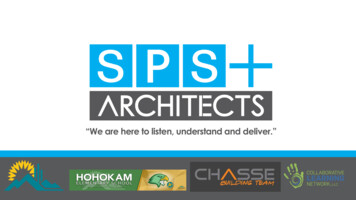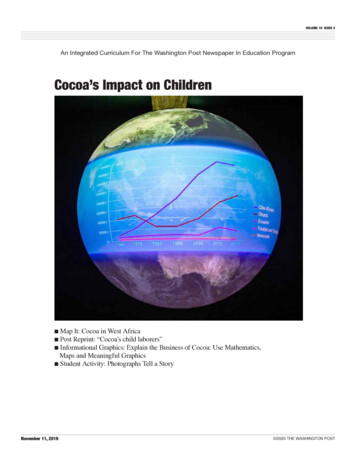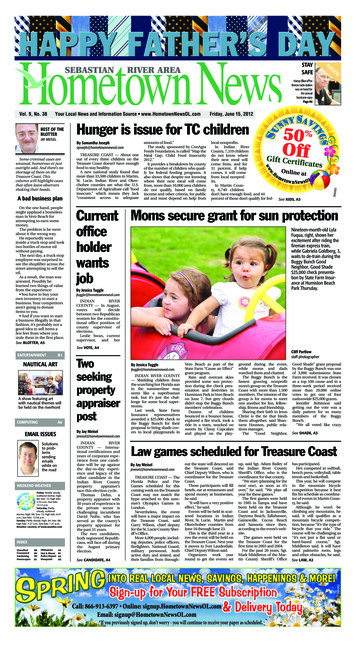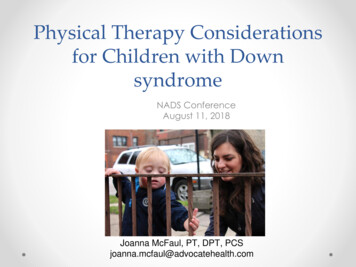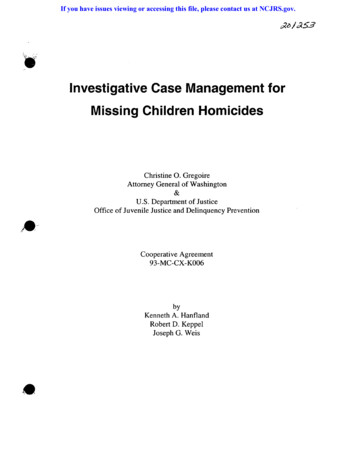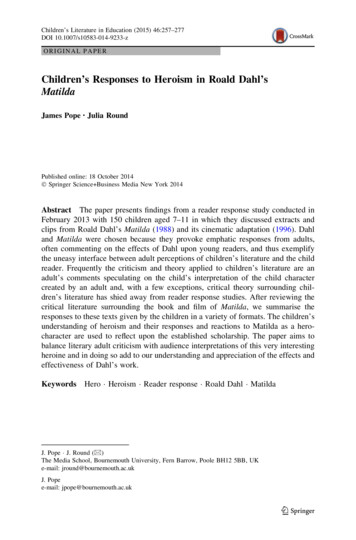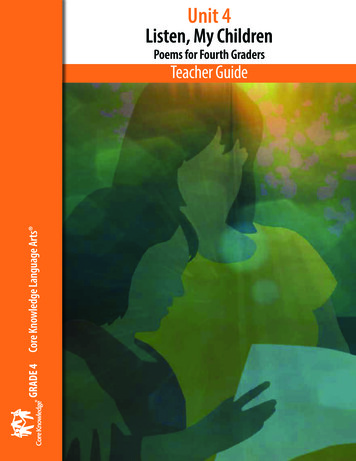
Transcription
Unit 4Listen, My ChildrenPoems for Fourth GradersGRADE 4 Core Knowledge Language Arts Teacher Guide
Unit 4Listen, My ChildrenPoems for Fourth GradersTeacher GuideGRADE 4Core Knowledge Language Arts
Listen, My ChildrenTeacher Guide was made possible with support from the Charles and Lynn SchustermanFamily Foundation.We would also like to thank Dr. Emily Chiariello (http://www.chiariello-consulting.com/)and Dr. Ebony Thomas (http://scholar.gse.upenn.edu/thomas) for their review of this Teacher Guide and fortheir insights and recommendations for resources and revisions, which have greatly enhanced this TeacherGuide. We also thank Robin McClellan and the teachers and coaches of Sulllivan County.This OER unit is offered as a supplement to the core CKLA program developed by the Core KnowledgeFoundation. The unit is not part of the current CKLA print program available for purchase from Amplify.However, as we gather more feedback on how this unit works in classrooms, Amplify and the CoreKnowledge Foundation will consider how this unit may be incorporated into future iterations of the coreCKLA program sold by Amplify.Creative CommonsLicensing This work is licensed under aCreative Commons Attribution-NonCommercial-ShareAlike4.0 International License.You are free:to Share—to copy, distribute, and transmit the workto Remix—to adapt the workUnder the following conditions: Attribution—Youmust attribute the work in the following manner:This work is based on an original work of the Core Knowledge Foundation (www.coreknowledge.org) made available throughlicensing under a Creative Commons Attribution-NonCommercialShareAlike 4.0 International License. This does not in any wayimply that the Core Knowledge Foundation endorses this work.Noncommercial—You may not use this workfor commercial purposes.Share Alike—If you alter, transform, or build upon this work, youmay distribute the resulting work only under the same or similarlicense to this one.With the understanding that:For any reuse or distribution, you must make clear toothers the license terms of this work. The best way todo this is with a link to this web /4.0/Copyright 2020 Core Knowledge Foundationwww.coreknowledge.orgAll Rights Reserved.Core Knowledge Language Arts , CKLA Core Knowledge , Core Knowledge CurriculumSeries , Core Knowledge History and Geography and CKHG are trademarks of the Core KnowledgeFoundation.Trademarks and trade names are shown in this book strictly forillustrative and educational purposes and are the property of theirrespective owners. References herein should not be regarded asaffecting the validity of said trademarks and trade names.
Table of ContentsAlignment Chart 1Introduction 9Lesson 121Lesson 230Lesson 339Lesson 447Lesson 553Lesson 659Lesson 765Lesson 871Lesson 977Lesson 1084Pausing Point86Answer Key87
Alignment to the Common Core State StandardsThe following chart indicates which lessons in the Poetry unit address content from the CommonCore State Standards (CCSS).Unit 4: Poetry123Lessons4 5 6 7PP89 10Reading Standards for LiteratureKey Ideas and DetailsSTD RL.4.1Refer to details and examples in a text when explaining whatthe text says explicitly and when drawing inferences from thetext.STD RL.4.2Determine a theme of a story, drama, or poem from details inthe text; summarize the text.STD RL.4.3Describe in depth a character, setting, or event in a storyor drama, drawing on specific details in the text (e.g., acharacter’s thoughts, words, or actions).Craft and SrtuctureSTD RL.4.4Determine the meaning of words and phrases as they areused in a text, including those that allude to significantcharacters found in mythology (e.g., Herculean).STD RL.4.5Explain major differences between poems, drama, and prose,and refer to the structural elements of poems (e.g., verse,rhythm, meter) and drama (e.g., casts of characters, settings,descriptions, dialogue, stage directions) when writing orspeaking about a text.STD RL.4.6PCompare and contrast the point of view from which differentstories are narrated, including the difference between firstand third-person narrations.Integration of Knowledge and IdeasSTD RL.4.7Make connections between the text of a story or drama and avisual or oral presentation of the text, identifying where eachversion reflects specific descriptions and directions in thetext.STD RL.4.8(Not applicable to literature)STD RL.4.9Compare and contrast the treatment of similar themesand topics (e.g., opposition of good and evil) and patternsof events (e.g., the quest) in stories, myths, and traditionalliterature from different cultures.Range of Reading and Level of Text ComplexitySTD RL.4.10By the end of the year, read and comprehend literature,including stories, dramas, and poetry, in the Grades 4–5 textcomplexity band proficiently, with scaffolding as needed atthe high end of the range.Core Knowledge Language Arts Grade 4PPPPP PPPPAlignment Chart Unit 41
Unit 4: Poetry123Lessons4 5 6 789 10Reading Standards for Informational TextKey Ideas and DetailsSTD RI.4.1Refer to details and examples in a text when explaining whatthe text says explicitly and when drawing inferences from thetext.STD RI.4.2Determine the main idea of a text and explain how it issupported by key details; summarize the text.STD RI.4.3Explain events, procedures, ideas, or concepts in a historical,scientific, or technical text, including what happened andwhy, based on specific information in the text.Craft and StructureSTD RI.4.4Determine the meaning of general academic and domainspecific words or phrases in a text relevant to a Grade 4 topicor subject area.STD RI.4.5Describe the overall structure (e.g., chronology, comparison,cause/effect, problem/solution) of events, ideas, concepts, orinformation in a text or part of a text.STD RI.4.6Compare and contrast a firsthand and secondhand accountof the same event or topic; describe the differences in focusand the information provided.Integration of Knowledge and IdeasSTD RI.4.7Interpret information presented visually, orally, orquantitatively (e.g., in charts, graphs, diagrams, time lines,animations, or interactive elements on Web pages) andexplain how the information contributes to an understandingof the text in which it appears.STD RI.4.8Explain how an author uses reasons and evidence to supportparticular points in a text.STD RI.4.9Integrate information from two texts on the same topic inorder to write or speak about the subject knowledgeably.Range of Reading and Level of Text ComplexitySTD RI.4.10By the end of year, read and comprehend informational texts,including history/social studies, science, and technical texts,in the Grades 4–5 text complexity band proficiently, withscaffolding as needed at the high end of the range.Reading Standards for Foundational Skills xxxxxPhonics and Word RecognitionSTD RF.4.3Know and apply grade-level phonics and word analysis skillsin decoding words.STD RF.4.3aUse combined knowledge of all letter-soundcorrespondences, syllabication patterns, and morphology(e.g., roots and affixes) to read accurately unfamiliarmultisyllabic words in context and out of context.2Unit 4 Alignment ChartGrade 4 Core Knowledge Language Arts
Unit 4: Poetry123Lessons4 5 6 789 10FluencySTD RF.4.4Read with sufficient accuracy and fluency to supportcomprehension.STD RF.4.4aRead grade-level text with purpose and understanding.STD RF.4.4bRead grade-level prose and poetry orally with accuracy,appropriate rate, and expression on successive readings.STD RF.4.4cUse context to confirm or self-correct word recognition andunderstanding, rereading as necessary.PPWriting StandardsSTD W.4.1Write opinion pieces on topics or texts, supporting a point ofview with reasons and information.STD W.4.1aIntroduce a topic or text clearly, state an opinion, andcreate an organizational structure in which related ideas aregrouped to support the writer’s purpose.STD W.4.1bProvide reasons that are supported by facts and details.STD W.4.1cLink opinion and reasons using words and phrases (e.g., forinstance, in order to, in addition).STD W.4.1dProvide a concluding statement or section related to theopinion presented.STD W.4.2Write informative/explanatory texts to examine a topic andconvey ideas and information clearly.STD W.4.2aIntroduce a topic clearly and group related information inparagraphs and sections; include formatting (e.g., headings),illustrations, and multimedia when useful to aidingcomprehension.STD W.4.2bDevelop the topic with facts, definitions, concrete details,quotations, or other information and examples related to thetopic.STD W.4.2cLink ideas within categories of information using words andphrases (e.g., another, for example, also, because).STD W.4.2dUse precise language and domain-specific vocabulary toinform about or explain the topic.STD W.4.2eProvide a concluding statement or section related to theinformation or explanation presented.STD W.4.3Write narratives to develop real or imagined experiences orevents using effective technique, descriptive details, andclear event sequences.STD W.4.3aOrient the reader by establishing a situation and introducinga narrator and/or characters; organize an event sequence thatunfolds naturally.STD W.4.3bUse dialogue and description to develop experiences andevents or show the responses of characters to situations.Core Knowledge Language Arts Grade 4PPAlignment Chart Unit 43
Unit 4: Poetry1STD W.4.3cUse a variety of transitional words and phrases to manage thesequence of events.STD W.4.3dUse concrete words and phrases and sensory details toconvey experiences and events precisely.STD W.4.3eProvide a conclusion that follows from the narratedexperiences or events.23Lessons4 5 6 789 10PPPPP PPPProduction and Distribution of WritingSTD W.4.4Produce clear and coherent writing in which thedevelopment and organization are appropriate to task,purpose, and audience. (Grade-specific expectations forwriting types are defined in standards 1–3 above.)STD W.4.5With guidance and support from peers and adults, developand strengthen writing as needed by planning, revising,and editing. (Editing for conventions should demonstratecommand of Language standards 1–3 up to and includingGrade 4 on page 29.)STD W.4.6With some guidance and support from adults, usetechnology, including the Internet, to produce and publishwriting as well as to interact and collaborate with others;demonstrate sufficient command of keyboarding skills totype a minimum of one page in a single sitting.Research to Build and Present KnowledgeSTD W.4.7Conduct short research projects that build knowledgethrough investigation of different aspects of a topic.STD W.4.8Recall relevant information from experiences or gatherrelevant information from print and digital sources; takenotes and categorize information, and provide a list ofsources.STD W.4.9Draw evidence from literary or informational texts to supportanalysis, reflection, and research.STD W.4.9aApply Grade 4 Reading standards to literature (e.g., “Describein depth a character, setting, or event in a story or drama,drawing on specific details in the text [e.g., a character’sthoughts, words, or actions].”).STD W.4.9bApply Grade 4 Reading standards to informational texts (e.g.,“Explain how an author uses reasons and evidence to supportparticular points in a text”).STD W.4.10Write routinely over extended time frames (time for research,reflection, and revision) and shorter time frames (a singlesitting or a day or two) for a range of discipline-specific tasks,purposes, and audiences.4Unit 4 Alignment ChartGrade 4 Core Knowledge Language Arts
Unit 4: Poetry123Lessons4 5 6 789 10Speaking and Listening StandardsComprehension and CollaborationSTD SL.4.1Engage effectively in a range of collaborative discussions(one-on-one, in groups, and teacher-led) with diversepartners on Grade 4 topics and texts, building on others’ideas and expressing their own clearly.STD SL.4.1aCome to discussions prepared, having read or studiedrequired material; explicitly draw on that preparation andother information known about the topic to explore ideasunder discussion.STD SL.4.1bFollow agreed-upon rules for discussions and carry outassigned roles.STD SL.4.1cPose and respond to specific questions to clarify or follow upon information, and make comments that contribute to thediscussion and link to the remarks of others.STD SL.4.1dReview the key ideas expressed and explain their own ideasand understanding in light of the discussion.STD SL.4.2Paraphrase portions of a text read aloud or informationpresented in diverse media and formats, including visually,quantitatively, and orally.STD SL.4.3Identify the reasons and evidence a speaker provides tosupport particular points.PPPPP PPPPPPPPP PPPPPresentation of Knowledge and IdeasSTD SL.4.4Report on a topic or text, tell a story, or recount an experiencein an organized manner, using appropriate facts and relevant,descriptive details to support main ideas or themes; speakclearly at an understandable pace.STD SL.4.5Add audio recordings and visual displays to presentationswhen appropriate to enhance the development of main ideasor themes.STD SL.4.6Differentiate between contexts that call for formal English(e.g., presenting ideas) and situations where informaldiscourse is appropriate (e.g., small-group discussion); useformal English when appropriate to task and situation.(See Grade 4 Language standards 1 on page 28 for specificexpectations.)Language StandardsConventions of Standard EnglishSTD L.4.1Demonstrate command of the conventions of standardEnglish grammar and usage when writing or speaking.STD L.4.1aUse relative pronouns (who, whose, whom, which, that) andrelative adverbs (where, when, why).STD L.4.1bForm and use the progressive (e.g., I was walking; I amwalking; I will be walking) verb tenses.Core Knowledge Language Arts Grade 4Alignment Chart Unit 45
Unit 4: Poetry1STD L.4.1cUse modal auxiliaries (e.g., can, may, must) to convey variousconditions.STD L.4.1dOrder adjectives within sentences according to conventionalpatterns (e.g., a small red bag rather than a red small bag).STD L.4.1eForm and use prepositional phrases.STD L.4.1fProduce complete sentences, recognizing and correctinginappropriate fragments and run-ons.STD L.4.1gCorrectly use frequently confused words (e.g., to, too, two;there, their).STD L.4.2Demonstrate command of the conventions of standardEnglish capitalization, punctuation, and spelling whenwriting.STD L.4.2aUse correct capitalization.STD L.4.2bUse commas and quotation marks to mark direct speech andquotations from a text.STD L.4.2cUse a comma before a coordinating conjunction in acompound sentence.STD L.4.2dSpell grade-appropriate words correctly, consultingreferences as needed.23Lessons4 5 6 789 10Knowledge of LanguageSTD L.4.3Use knowledge of language and its conventions whenwriting, speaking, reading, or listening.STD L.4.3aChoose words and phrases to convey ideas precisely.STD L.4.3bChoose punctuation for effect.STD L.4.3cDifferentiate between contexts that call for formal English(e.g., presenting ideas) and situations where informaldiscourse is appropriate (e.g., small-group discussion).Vocabulary Acquisition and UseSTD L.4.4Determine or clarify the meaning of unknown and multiplemeaning words and phrases based on Grade 4 reading andcontent, choosing flexibly from a range of strategies.STD L.4.4aUse context (e.g., definitions, examples, or restatements intext) as a clue to the meaning of a word or phrase.STD L.4.4bUse common, grade-appropriate Greek and Latin affixesand roots as clues to the meaning of a word (e.g., telegraph,photograph, autograph).STD L.4.4cConsult reference materials (e.g., dictionaries, glossaries,thesauruses), both print and digital, to find the pronunciationand determine or clarify the precise meaning of key wordsand phrases.STD L.4.56PPPPP PPPPPPPPPP PPPPDemonstrate understanding of figurative language, wordrelationships, and nuances in word meanings.Unit 4 Alignment ChartGrade 4 Core Knowledge Language Arts
Unit 4: Poetry1STD L.4.5aExplain the meaning of simple similes and metaphors (e.g., aspretty as a picture) in context.STD L.4.5bRecognize and explain the meaning of common idioms,adages, and proverbs.STD L.4.5cDemonstrate understanding of words by relating them totheir opposites (antonyms) and to words with similar but notidentical meanings (synonyms).STD L.4.6Acquire and use accurately grade-appropriate generalacademic and domain-specific words and phrases, includingthose that signal precise actions, emotions, or states of being(e.g., quizzed, whined, stammered) and that are basic to aparticular topic (e.g., wildlife, conservation, and endangeredwhen discussing animal preservation).Core Knowledge Language Arts Grade 423Lessons4 5 6 789 10PPPPPPP PPPPAlignment Chart Unit 47
IntroductionUnit 4: Poetry: Listen, My ChildrenINTRODUCTION TO CKLAWelcomeThis introduction includes the necessary background information to teach the CKLAGrade 4 Poetry unit. This unit includes ten lessons which provide explicit instructionin reading, writing, and spelling. It is designed to follow the Grade 4 CKLA unit KingArthur and the Round Table.Each entire lesson will require a total of 90 minutes. During the final lesson,students will complete the Poetry Unit Assessment. Following the completion of theUnit Assessment several culminating activities are suggested from which teachers maychoose.Lessons and activities in this unit address various aspects of a comprehensivelanguage arts curriculum aligned to the Common Core State Standards-EnglishLanguage Arts (CCSS-ELA): reading, writing, spelling, grammar, and morphology. Referto the alignment chart in this guide to identify which lessons in the Poetry unit addresscontent from the Core Knowledge Sequence (Core Content Objectives) and the CCSS.Why the Poetry Unit Is ImportantThe Poetry unit includes poems from the Core Knowledge publication, Listen,My Children: Poems for Fourth Graders. The poems contained in this publicationinclude the specific poems recommended for students in this grade level in the CoreKnowledge Sequence. Each student should have his/her own copy of this volume ofpoetry.It is important for students to study poetry as a genre of literature for many reasons.Not only does the genre allow students to study literary techniques unique to poetry,but it exposes students to deep philosophical thoughts and emotional issues notalways present in prose. In this unit, students will encounter “Humanity,” a poem byElma Stuckey, which addresses the issues of racial identity and inclusion. In addition,students will study the poem “Concord Hymn” by Ralph Waldo Emerson. Althoughthe topic of this poem is the early battle in the American Revolution, it does not dwellon details of the battle, as might be done in a piece of prose; instead, it encapsulatesa sense of American pride and patriotism surrounding the event in a way not as easilyaccomplished in prose.In this unit, as students read the selected poems, they will focus on literary techniquesused in that poetry, such as figurative language, rhyme schemes, metaphor, andCore Knowledge Language Arts Grade 4Introduction Unit 49
repetition. Students will also examine specific vocabulary associated with poetry,including stanza, verse, free verse, and narrative poem. Students will also be able todistinguish poetry from prose.Core Content Objectives Addressed in Core Knowledge Language Arts duringPrevious Grades and UnitsStudents who have received Core Knowledge Language Arts (CKLA) instruction in Grades K–3will already have pertinent knowledge of the important narrative elements of stories, myths,and other literary works.Nursery Rhymes and Fables (Kindergarten) Describe the characters and/or events in nursery rhymes and fables Identify rhyming words in nursery rhymes Identify lines that repeat in nursery rhymes Identify dialogue in
and refer to the structural elements of poems (e.g., verse, rhythm, meter) and drama (e.g., casts of characters, settings, descriptions, dialogue, stage directions) when writing or speaking about a text. P STD RL.4.6 Compare and contrast the point of view from which different stor

